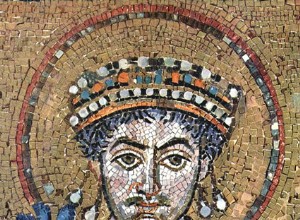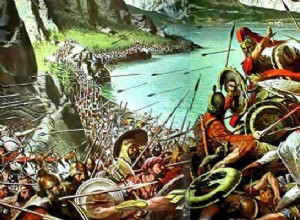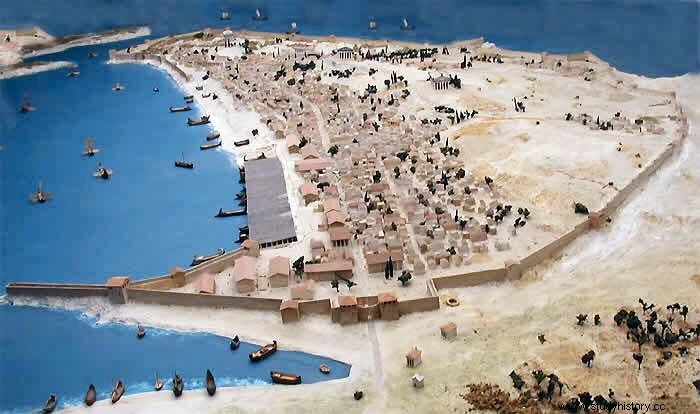 Massalia (now Marseille) was founded around 600 BC by Greeks from Phocaea, in Asia Minor. It is for this reason that Marseille is called the “city of Marseille”. This prosperous colony, which then bears the name of Massalia, had a special destiny and a special place in the history of Gaul and the western Mediterranean. Allied with Rome against Carthage, it became a center of settlement for the Celts of Gaul. After having supported Pompey in the civil war which opposed him to Julius Caesar, the city was annexed by the latter in 49 BC within the Roman Empire, becoming Massilia .
Massalia (now Marseille) was founded around 600 BC by Greeks from Phocaea, in Asia Minor. It is for this reason that Marseille is called the “city of Marseille”. This prosperous colony, which then bears the name of Massalia, had a special destiny and a special place in the history of Gaul and the western Mediterranean. Allied with Rome against Carthage, it became a center of settlement for the Celts of Gaul. After having supported Pompey in the civil war which opposed him to Julius Caesar, the city was annexed by the latter in 49 BC within the Roman Empire, becoming Massilia .
The original myth of the foundation of Massalia
According to the tradition of the Phocaeans of Asia, guided by Artemis, would have arrived in Lazio and would have met King Numa with whom they would have sealed a treaty of friendship. The fleet led by Samos and Protis arrives on the Marseille shores. They then returned home and returned with more individuals by their side. They made contact with the king of Ségobriges Nann to found a city. The Ségobriges are the Ligurian people who occupied the Marseille area. We know little about them. King Nann accepts and then gives in marriage.
 Thus was founded the colony of Massalia. This idyllic foundation hides the fact that the problems between natives and Greeks erupt from the succession as early as the reign of the son of King Nannos.
Thus was founded the colony of Massalia. This idyllic foundation hides the fact that the problems between natives and Greeks erupt from the succession as early as the reign of the son of King Nannos.
An oligarchic regime
Massalia is run by the Council of the Timouques, namely 600 men appointed for life, each of whom comes from a family descending from the first settlers. Fifteen members are at the head of this assembly and manage the affairs of the city. Among these fifteen, three have more power than the others and one of them has preeminence over the whole system. This assembly is very conservative and wishes to preserve their Greek identity.
This conservatism is reinforced by the geopolitical situation of the city which sees itself as “a Greek island in the midst of barbarians”. According to Mr. Clavel-Lévêque, the practice of commerce would have been linked in the city to the obtaining of political rights. This city fascinated Roman writers who hoped to find there the nostalgic values of a bygone era.
Rapid growth
The growth of Massalia is rapid as illustrated by the extension of the enclosures throughout the independence of the city. The arrival of new Phocaeans following the destruction of their city of origin greatly contributed to this dynamism. The city also became independent following the fall of Phocaea in the second half of the 6th century. Located between the Butte des Carmes and the Butte Saint-Laurent, the city is expanding rapidly and has ramparts, a port and public facilities.
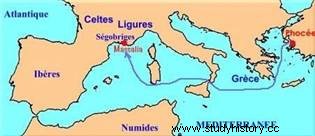 Two important sanctuaries are built:the Ephesion and the sanctuary of Apollo Delphinios. Their exact locations are difficult. Growth is not only urban:if the city has remained with a chôra (agricultural space surrounding a city) restricted for a relatively long time. It has very early a coinage which is diffused from the end of the 6th and the first half of the 5th century.
Two important sanctuaries are built:the Ephesion and the sanctuary of Apollo Delphinios. Their exact locations are difficult. Growth is not only urban:if the city has remained with a chôra (agricultural space surrounding a city) restricted for a relatively long time. It has very early a coinage which is diffused from the end of the 6th and the first half of the 5th century.
Massalia, a prosperous city against its neighbors
Massalia, as we said before, is seen as a besieged city. She founded many colonies like Hyères (Olbia ), Antibes (Antipolis ) or Nice (Nikaia ) to prevent Ligurian or Celtic attacks. The Roman alliance is then vital for her. The Roman invasion in southern Gaul between 125 and 122 is linked to this situation. It also acquires territories following this intervention. Despite this difficult general situation, Massalia is holding its own:the city produces quality wine which is exported throughout the western Mediterranean. She introduced the cultivation of vines and olive trees in Gaul at the same time.
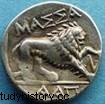 Contrary to popular belief, pollen and carpological studies have shown that the vine and the olive tree existed before the arrival of the Greeks. Arboriculture (pruning and grafting) is introduced. It also produces ceramics, oil and bronze. Its crossroads position makes it a shopping center. Finally, we cannot mention the influence exerted by Marseille on its neighbours. We will take only two examples:the Greek alphabet is used consistently by the Gauls. Glanum, an indigenous city, became monumental after the sacking of the city in 125-124 and acquired buildings characteristic of Greek culture.
Contrary to popular belief, pollen and carpological studies have shown that the vine and the olive tree existed before the arrival of the Greeks. Arboriculture (pruning and grafting) is introduced. It also produces ceramics, oil and bronze. Its crossroads position makes it a shopping center. Finally, we cannot mention the influence exerted by Marseille on its neighbours. We will take only two examples:the Greek alphabet is used consistently by the Gauls. Glanum, an indigenous city, became monumental after the sacking of the city in 125-124 and acquired buildings characteristic of Greek culture.
The decline and fall of Massalia
The wealth of Massalia is linked to the Rhône. Goods transited in pre-industrial societies mainly by water because of lower costs. The Rhone being considered as the Phocaean way until the end of the Massaliote domination, the Romans rather invested, initially, "the Gallic isthmus" (Aude-Garonne) while not neglecting however to weave a network diplomacy in the Rhodano-Saonian axis. From the middle of the 2nd century BC. AD, Rome is allied to the Aedui. From 150-130 BC. J.-C., archeology has shown that the production of Italian amphoras supplanted those of the Phocaeans in Marseille. We can also see this decline with the evolution of the coinage of the city. Finally, the foundation of Aix-en-Provence in 122 BC. J.-C. could go in the direction of a more acute control of the trade on the valley of the Rhone and thus to compete with Massalia on this axis.
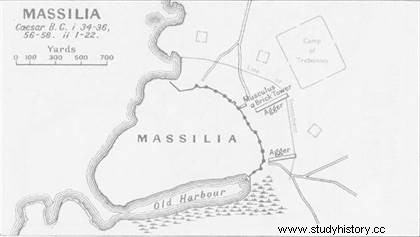 During the civil wars, Massalia made the wrong choice of choosing Pompey over Caesar. Caesar besieged the city for six months in 49 BC. J.-C. César would not have plundered the city because of the old friendship. Massalia emerges very weakened from this siege which does not help his economic decline and confirms, if it were still needed, the dominant position of Rome in this region. The city saw itself cut off from part of its territory and its colonies and kept only Nice and the Stoechades Islands. It remains a free city but cannot have an independent foreign policy.
During the civil wars, Massalia made the wrong choice of choosing Pompey over Caesar. Caesar besieged the city for six months in 49 BC. J.-C. César would not have plundered the city because of the old friendship. Massalia emerges very weakened from this siege which does not help his economic decline and confirms, if it were still needed, the dominant position of Rome in this region. The city saw itself cut off from part of its territory and its colonies and kept only Nice and the Stoechades Islands. It remains a free city but cannot have an independent foreign policy.
Massilia, a revitalized Roman city
It seems that the final conquest does not lead to a total decline. It is gradually adorned with Roman architecture:we know of the existence of two thermal baths in Marseille. A theater accompanied by a monumental complex shows that in Roman times the city experienced significant vitality. Trade does not seem to be weakening, on the contrary:warehouses have been built on areas reclaimed from the sea. However, Massilia has become a city like the others.
Its institutions have changed but do not stick to the classic model of the Western city. Thus, epigraphy teaches us that in the 2nd and 3rd century AD there were still circulating agonothets of the games of Jupiter, of the prophets and of the episcopi of the people of Nice. One still finds Greek inscriptions in spite of the wide diffusion of Latin. Thus, the city is no longer quite a Greek city because it adopted the principle of classical local institutions with decurions, nor a Roman city. Marseille is Athens where young Romans of good society come to perfect their education like the famous governor Agricola.
After the period of the High Empire, the city was affected by Christianity from the 3rd century with its share of martyrs. Oresius, the first known bishop of Marseilles, was present at the Council of Arles organized by the Emperor Constantine in 314. This city was a prodigious city and its influence went beyond its sole sphere of influence. We could have mentioned in this article the journeys of Pytheas and Euthymenes which during the period of independence allowed a broadening of geographical knowledge. Marseille has therefore been a gateway to the world since antiquity.
Bibliography
- COLLIN BOUFFIER Sophie, "Marseille and Mediterranean Gaul before the Roman conquest", Pallas, 2009, pp. 35-60.
- FERDIÈRE Alain, The Gauls:2nd century BC-5th century AD. J.C., Armand Colin, Paris, 2005.
- HERMARY Antoine, HESNARD Antoinette and TRÉZINY Henri, Greek Marseilles. The Phocaean city, Errance, Paris, 1999.
- ROTHÉ Marie-Pierre and TRÉZINY Henry, Archaeological Map of Gaul 13/3 Marseille and its surroundings, House of Human Sciences, Paris, 2005.

